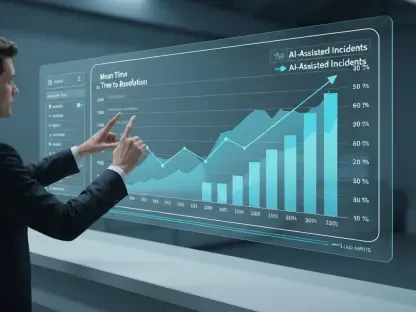In the rapidly evolving landscape of software development, automation stands as a cornerstone of modern DevOps and continuous delivery pipelines, promising to slash release cycles and boost operational efficiency. Yet, despite its allure, many organizations find themselves grappling with unexpected failures—critical defects slipping into production, frustrated end users, and costly rework. The root cause often lies not in the tools themselves, but in a fundamental oversight: the absence of a strategic quality assurance (QA) mindset. This perspective, grounded in critical thinking, risk anticipation, and a relentless focus on user needs, is essential to ensure that automation delivers on its potential. Speed without direction can lead to disaster, and automation without a thoughtful QA approach risks becoming a hollow exercise. This discussion delves into the reasons automation stumbles and how embedding a strategic QA framework can transform challenges into sustainable success, balancing velocity with uncompromised quality.
Uncovering the Hidden Flaws in Automation
Automation is frequently celebrated for its ability to accelerate software releases, often reducing cycle times by a remarkable margin compared to manual efforts. However, this speed can mask significant shortcomings when not paired with a guiding strategy. Automated scripts might execute without error, yet fail to catch critical issues if they’re based on outdated assumptions or overly rigid parameters. For instance, a test may pass while validating incorrect functionality simply because it wasn’t updated to reflect new business rules. Such oversights lead to defects reaching production, eroding user trust and burdening teams with urgent fixes. The core issue is a misplaced emphasis on velocity over adaptability, where the rush to deploy overshadows the need for tests that evolve alongside the software. Without a deliberate focus on what truly matters—ensuring real-world reliability—automation becomes a superficial tool, unable to address the nuanced demands of dynamic development environments.
Moreover, the pitfalls of automation extend beyond outdated scripts to a lack of foresight in test design. Many teams prioritize breadth of coverage over depth, automating a vast array of scenarios without considering which ones pose the greatest risk. This scattershot approach often misses edge cases or unique user behaviors that only surface under specific conditions. The consequence is software that appears stable in testing but falters when faced with real-world complexities. A stark example is when automated tests overlook rare but catastrophic failure points, leading to significant disruptions post-launch. Addressing this requires a shift in perspective—moving away from merely automating everything toward curating tests that target high-impact areas. By critically assessing where failures are most likely to occur and aligning automation accordingly, teams can avoid the trap of false security and ensure that their efforts yield meaningful protection against defects.
Building Quality from the Ground Up
Integrating QA into the earliest stages of software development is a game-changer for ensuring automation’s success. Rather than relegating QA to a final validation step, involving QA professionals during requirement gathering and design phases embeds quality into the product’s very foundation. This proactive stance allows for a deeper understanding of business objectives and user expectations, enabling tests to be crafted with precision from the outset. Collaboration with developers and product owners at this stage helps identify potential risks before they manifest, ensuring that automated scripts are built to address specific, relevant challenges. The result is a more robust product where quality isn’t an afterthought but a core component, reducing the likelihood of expensive revisions later. Early QA involvement transforms automation from a reactive measure into a strategic asset that supports long-term stability.
Additionally, continuous QA engagement throughout the development lifecycle amplifies the benefits of early involvement. As projects evolve, so do requirements and potential pitfalls, necessitating ongoing adjustments to testing strategies. A persistent QA presence ensures that automation remains aligned with shifting priorities, catching discrepancies as they arise rather than after deployment. This dynamic approach also fosters a culture of shared responsibility, where quality becomes a collective goal rather than a siloed task. For example, regular feedback loops between QA and development teams can refine automated tests to reflect real-time changes in user needs or technical specifications. Such adaptability prevents the accumulation of technical debt and minimizes production incidents. By maintaining QA as an integral, continuous process, organizations can harness automation to deliver software that consistently meets high standards of reliability and user satisfaction.
Prioritizing Risk and User Experience
A strategic QA mindset fundamentally shifts the focus of testing from mere code coverage to a risk-based, user-centric approach. Instead of aiming to test every possible scenario, this perspective zeroes in on where failures are most likely to occur and how they would impact end users. It involves asking probing questions like, “What are the weakest links in this system?” and “Does this feature genuinely solve a user’s problem?” By directing automation toward these critical areas, teams can uncover defects that matter most, preventing minor issues from becoming major headaches. This method ensures that testing isn’t just a checkbox activity but a meaningful safeguard against real-world disruptions. The emphasis on user workflows also guarantees that software isn’t merely functional in theory but practical and effective in actual use, enhancing overall satisfaction and trust.
Furthermore, adopting a user-focused QA mindset encourages a healthy skepticism that challenges assumptions baked into development. Automated tests often reflect what developers expect to happen, not what might go wrong under unexpected conditions. A strategic QA approach counters this by exploring beyond the obvious, designing tests that simulate diverse user interactions and stress points. This curiosity-driven exploration often reveals hidden vulnerabilities that standard automation would miss, such as usability flaws or performance bottlenecks during peak usage. By anticipating these scenarios, QA professionals can refine automation to cover not just the happy path but also the myriad ways users might interact with the software. The outcome is a product that withstands scrutiny from all angles, delivering a seamless experience that aligns with user needs while minimizing the risk of costly post-release issues.
Balancing Automation with Human Judgment
While automation shines in handling repetitive tasks like regression testing and data validation, it falls short in areas requiring nuanced analysis. Assessing complex business logic, exploring uncharted failure modes, or evaluating the intuitiveness of a user interface demands human insight that no script can replicate. For instance, an automated test might confirm that a feature works as coded, but only a human tester can determine if it feels clunky or confusing to the end user. Relying solely on automation for such validations risks delivering software that meets technical specs but alienates its audience. A hybrid model, where automation ensures consistency in routine checks and human testers dive into creative and experiential assessments, offers a balanced solution. This synergy leverages the strengths of both approaches, ensuring comprehensive quality that neither could achieve alone.
Equally important is the role of human judgment in adapting to evolving contexts that automation cannot predict. Software requirements often shift mid-cycle due to market changes or user feedback, rendering pre-programmed tests obsolete if not updated. Human testers bring the flexibility to reassess priorities, redesign test scenarios, and explore new risks on the fly—capabilities beyond the scope of even the most sophisticated automation tools. This adaptability is crucial during exploratory testing, where uncovering unexpected issues can make the difference between a successful launch and a flawed one. By pairing human-driven exploration with automated stability checks, teams can address both the predictable and the unforeseen. Such a dual approach not only enhances the reliability of the software but also builds confidence among stakeholders that quality remains paramount, even as deadlines loom.
Crafting a Path to Sustainable Quality
Reflecting on the challenges of automation, it becomes evident that past failures often stemmed from an overemphasis on speed at the expense of strategic oversight. Many teams rushed to automate without considering how to align tests with real risks or user expectations, resulting in overlooked defects and frustrated customers. Historical cases showed that automation, when applied without a guiding QA mindset, frequently validated the wrong outcomes or missed critical edge cases, leading to preventable disruptions. The lesson is clear: tools alone cannot ensure quality without a deliberate framework to steer their application. Those who ignored the need for early QA integration or human insight often paid a steep price in rework and lost credibility, underscoring the necessity of a balanced perspective in software testing.
Looking ahead, the path to sustainable quality lies in actionable strategies that address past shortcomings. Teams should commit to designing automation scripts that remain flexible to change, prioritizing risk-based testing to focus on high-stakes areas. Blending manual testing for complex validations with automated checks for routine tasks ensures a comprehensive approach. Beyond tactics, fostering collaboration across roles—making QA a shared priority rather than a standalone function—builds a culture of excellence. As development pipelines continue to accelerate, adopting these practices will empower organizations to harness automation effectively, turning it into a true enabler of quality. By learning from previous missteps and embedding strategic QA principles, the industry can move toward a future where speed and reliability coexist, delivering software that consistently meets the mark.









